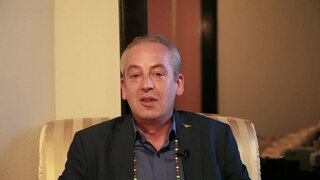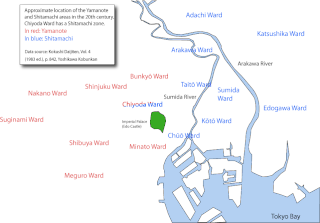Austrian German, Austrian Standard German (ASG), Standard Austrian German, or Austrian High German, is the variety of Standard German written and spoken in Austria. It has the highest sociolinguistic prestige locally, as it is the variation used in the media and for other formal situations. In less formal situations, Austrians tend to use forms closer to or identical with the Bavarian and Alemannic dialects, traditionally spoken – but rarely written – in Austria.
The term dialect is used in two distinct ways to refer to two different types of linguistic phenomena:

German is a West Germanic language that is mainly spoken in Central Europe. It is the most widely spoken and official or co-official language in Germany, Austria, Switzerland, South Tyrol in Italy, the German-speaking Community of Belgium, and Liechtenstein. It is one of the three official languages of Luxembourg and a co-official language in the Opole Voivodeship in Poland. The German language is most similar to other languages within the West Germanic language branch, including Afrikaans, Dutch, English, the Frisian languages, Low German/Low Saxon, Luxembourgish, and Yiddish. It also contains close similarities in vocabulary to Danish, Norwegian and Swedish, although they belong to the North Germanic group. German is the second most widely spoken Germanic language, after English.
In linguistics, grammar is the set of structural rules governing the composition of clauses, phrases and words in a natural language. The term refers also to the study of such rules and this field includes phonology, morphology and syntax, often complemented by phonetics, semantics and pragmatics.
Bokmål is an official written standard for the Norwegian language, alongside Nynorsk. Bokmål is the preferred written standard of Norwegian for 85% to 90% of the population in Norway. Unlike, for instance, the Italian language, there is no nationwide standard or agreement on the pronunciation of Bokmål.

Standard German, High German or more precisely Standard High German, is the standardized variety of the German language used in formal contexts and for communication between different dialect areas. It is a pluricentric Dachsprache with three codified specific regional variants: German Standard German, Austrian Standard German and Swiss Standard German.
Westphalian or Westfalish/Westphalish is one of the major dialect groups of West Low German. Its most salient feature is its diphthongization. For example, speakers say iäten instead of etten or äten for "to eat".
A standard language is a language variety that has undergone substantial codification of grammar and usage, and is employed by a population for public communication. The term standard language occasionally refers to the entirety of a language that includes a standardized form as one of its varieties. Typically, the language varieties that undergo substantive standardization are the dialects spoken and written in centers of commerce and government. By processes that linguistic anthropologists call "referential displacement" and that sociolinguists call "elaboration of function", these varieties acquire the social prestige associated with commerce and government. As a sociological effect of these processes, most users of this language come to believe that the standard language is inherently superior, or consider it the linguistic baseline against which to judge other varieties of language.

In linguistics, diglossia is a situation in which two dialects or languages are used by a single language community. In addition to the community's everyday or vernacular language variety, a second, highly codified lect is used in certain situations such as literature, formal education, or other specific settings, but not used normally for ordinary conversation. In most cases, the H variety has no native speakers but various degrees of fluency of the community in which the two languages exist.
Viennese German is the city dialect spoken in Vienna, the capital of Austria, and is counted among the Bavarian dialects. It is distinct from written Standard German in vocabulary, grammar, and pronunciation. Even in Lower Austria, the state surrounding the city, many of its expressions are not used, while farther to the west they are often not even understood.
The German-based varieties spoken by German Brazilians together form a significant minority language in Brazil. "Brazilian German" is strongly influenced by Portuguese and to a lesser extent by Italian dialects as well as indigenous languages. German dialects and Germanic languages are particularly strong in Brazil's South and Southeast Regions. According to Ethnologue, ca. 3 million people in Brazil speak the Hunsrik Language, 1.5 million speak Standard German and 8,000 speak Plautdietsch.
In sociolinguistics, prestige is the level of regard normally accorded a specific language or dialect within a speech community, relative to other languages or dialects. Prestige varieties are language or dialect families which are generally considered by a society to be the most "correct" or otherwise superior. In many cases, they are the standard form of the language, though there are exceptions, particularly in situations of covert prestige. In addition to dialects and languages, prestige is also applied to smaller linguistic features, such as the pronunciation or usage of words or grammatical constructs, which may not be pronounced enough to constitute a separate dialect. The concept of prestige provides one explanation for the phenomenon of variation in form, among speakers of a language or languages.

The formally independent municipality Rethen is part of the municipality Vordorf in Northern Germany. First documented in 1301, it now has a population of about 1,200. Rethen is part of the Samtgemeinde Papenteich at the administrative district of Gifhorn. Together with the villages Vordorf and Eickhorst it forms the municipality Vordorf which is situated halfway between Braunschweig and Gifhorn.

Sauris is a comune (municipality) in the Province of Udine in the Italian region Friuli-Venezia Giulia. At an elevation of 1,212 m (3,976 ft), it is the highest municipality in the region and one of the German language islands in Northeast Italy. Sauris is part of the Alpine pearls cooperation for sustainable tourism.
Swiss Standard German, or Swiss High German, referred to by the Swiss as Schriftdeutsch, or Hochdeutsch, is the written form of one of four official languages in Switzerland, besides French, Italian and Romansh. It is a variety of Standard German, used in the German-speaking part of Switzerland. It is mainly written, and rather less often spoken.

Didderse is a municipality in the district of Gifhorn, in Lower Saxony, Germany. It is a member municipality of the Samtgemeinde Papenteich.

Rötgesbüttel is a municipality in the district of Gifhorn, in Lower Saxony, Germany. It is a member municipality of the Samtgemeinde Papenteich

Schwülper is a municipality in the district of Gifhorn, in Lower Saxony, Germany. It is a member municipality of the Samtgemeinde Papenteich. The Municipality Schwülper includes the villages of Groß Schwülper, Hülperode, Klein Schwülper, Lagesbüttel, Rothemühle and Walle

Tokyo dialect is the Japanese dialect spoken in modern Tokyo. The dialect in modern Tokyo is often considered to be Standard Japanese, but they differ in a number of areas and social classes.
Kyirong is a language from the subgroup of Tibetic languages spoken in the Gyirong County of the Shigatse prefecture, of the Tibetan Autonomous Region.














